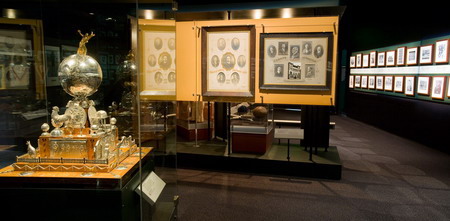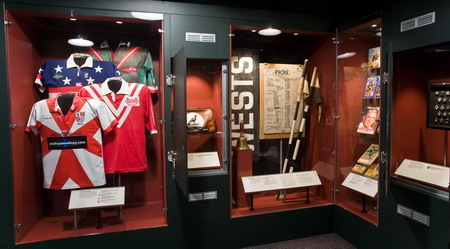review by Michael McKernan
The first academic conference on the history of sport in Australia, The Making of Sporting Traditions, was held at the University of New South Wales in 1977. As the participants moved into the lecture theatre for the opening session, we were harangued by an angry economic historian on the university's payroll who seemed to believe that the serious study of sport had no place at a university. Determined to justify the academic study of sport we concentrated on class and race and gender and money and national values. We concentrated on the things historians do and we felt justified in spending time and effort in talking about sport.
Stand for a while in this exhibition at the National Museum of Australia and you will see a forthright refutation of the silly academic elitism of the economic historian, if anyone would be mad enough still to advance it. My second visit to League of Legends was particularly instructive. A quiet early-in-the week rainy afternoon yet the exhibition was attracting a steady flow of visitors, deeply enough engaged with the objects and the story to show that they loved their footy. They brought to the museum a love and knowledge of rugby league, their code, their passion, that they expected the exhibition to confirm. It is always a thrill to be in a museum when it is crystal clear that its collections and its story are working for its intended audience.
National Museum of Australia

photograph by Jason McCarthy
National Museum of Australia

National Museum of Australia
The design of the exhibition is accessible and vaguely kitsch. There is a modest attempt to recreate the locker room feel of sport, but without any of the chaos and jumble that footballers seem to like. The light levels are fine, for many of the objects are far from fragile, though what look like knitted jumpers would deteriorate in too much light. The captions are clear and easy to read and remarkably neutral. The design and layout encourages the visitor, certainly does not intimidate, and assumes interest and involvement.
The central fact about rugby league, as this exhibition makes very clear from the outset, is that it was a radical breakaway from rugby union. This meant, of course, that in the rugby league states there was permanent rivalry between two strong football codes. A comparison with the dominance of Australian Rules football in the southern states shows how important the division between league and union was. In New South Wales and Queensland, football was divided along class, religious and even political lines, whereas in Victoria, for example, football united all the people, or more often united them in the love of the game while dividing them along club and locality lines.

National Museum of Australia
Good exhibitions, like good books, should make you think, and I came away from League of Legends thinking hard about what sport is for. In this exhibition it is about playing, winning, recalling; it is about mates and places and some change and development. It is about great players and great moments. But sport is more. It is about money and influence, it is about community and class, it is at the heart of who we are. League of Legends might have done more; but it is giving those who know and love their league a mighty good time, anyway.
Michael McKernan is a writer and broadcaster, and author of The Brumbies: The Super 12 Years.
| Institution: | National Museum of Australia |
| Curatorial team: | Guy Hansen, Cinammon van Reyk, Adrian Henham, Aaron Pegram |
| Historical consultant: | Ian Heads |
|
Design: | Acumen Design |
| Exhibition space: | 600 square metres |
| Venue/dates: |
National Museum of Australia, Canberra, 8 March – 11 May 2008
Queensland
New South Wales National Sports Museum, Melbourne, April–July 2009 (reduced version) |
| Publication: | League of Legends: 100 Years of Rugby League in Australia, National Museum of Australia Press, 2008. RRP $19.95 |
